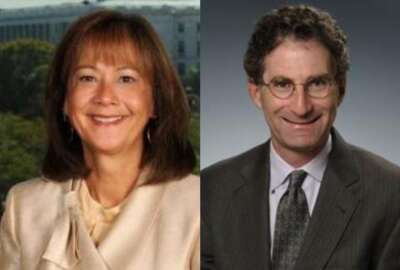
VA expects new pay model for federal IT workforce will help it fill 1,000 positions
The Veterans Affairs Department is on a hiring spree for IT talent, and recruiting private-sector employees hit by industry-wide layoffs to join its ranks.
The Department of Veterans Affairs is on a hiring spree for IT talent, and recruiting private-sector employees hit by industry-wide layoffs to join its ranks.
VA’s Office of Information Technology is actively recruiting laid-off tech workers to fill about 1,000 agency vacancies. The agency is specifically looking to fill positions in software development, product management and cybersecurity.
VA Chief Information Officer Kurt DelBene said the agency is reaching out to IT workers with in-demand skills at top tech companies — including Twitter, Meta, Amazon, Stripe and Microsoft — that have been part of “across the board” layoffs.
“You’re seeing layoffs kind of commensurate with what you saw back in 2000,” DelBene told reporters Friday. “And it’s happening at the same time that we’re really trying, and being successful in doing a transformation of IT at the VA.”
About 50,000 private-sector tech employees received layoff notices in November, and about 100,000 total tech workers were laid off this year.
The VA expects it will soon be able to offer these new IT hires a higher maximum salary than what they could previously earn under the General Schedule pay scale.
DelBene said agencies are “getting towards having final approval” from the Office of Personnel Management for a Special Salary Rate for federal IT hires. He said he expects OPM will finalize its approval by January.
“They are equally enthusiastic as we are to get it over the finish line, and so we don’t see it becoming an issue,” he said. “If you think about the administration and having a tech agenda, this would be high on their list of things to do.”
The Special Salary Rate for IT employees in the federal workforce, if approved, would mark the first major governmentwide step to address a core component of its IT workforce challenges.
The VA led a coalition of agencies submitting the SSR proposal this summer. Those other agencies include the Cybersecurity and Infrastructure Security Agency, the Department of Health and Human Services, the State Department and the Energy Department.
The Department of Homeland Security broke ground on this work last year when it unveiled its cybersecurity talent management system. The project took seven years to complete, once Congress in 2014 gave DHS the authority to develop a cyber hiring, job classification and compensation framework separate from the federal government’s traditional practices.
“Each of the departments gets to decide, are they going to adopt the SSR, and how are they going to do that? We’re going for it, obviously, since we were one of the folks that were the primary proposers of it,” DelBene said.
The SSR isn’t intended to match what some of the biggest tech companies are able to pay their employees, but will at least close the gap for IT workers considering a career in government service.
“We don’t think it needs to be a compromise that you make in terms of compensation, and we’re doing the right things to make that happen,” DelBene said.
VA OIT looking to recruit ‘virtual-first workforce’
DelBene said VA OIT is proactively reaching out to the private-sector tech community and making the case for public service.
“We get a lead, we follow that lead. We see what their interest would be. We shepherd them through the system and really get them on board as quickly as we can,” he said.
VA Chief Technology Officer Charles Worthington said hundreds of private-sector tech workers have reached out to VA to learn more about a career in government. VA OIT also held a job fair this week that attracted up to 500 prospective hires.
“We have seen an uptick in interest, as we have had this opportunity to try to fill these 1,000 positions,” Worthington said.
VA OIT set up a specific email inbox to field inquiries from people leaving the private tech sector and interested in joining the agency. Prospective applicants can email OITcareers@va.gov to learn more about the federal hiring process.
VA Chief Technology Officer Charles Worthington said the email inbox is an “addendum” to the federal hiring process, and that prospective hires still need to apply online at USAJobs.gov to be considered.
“What the email address allows us to do is make contact with candidates and answer their questions — sort of like a talent team would do at a private sector company, where we can answer their questions ahead of time. Maybe they’re asking about pay rates or work flexibilities. The fact that we have a distributed team, with people all across the country, rather than making people all come to Washington, D.C. is something a lot of people have questions about,” Worthington said.
DelBene, who said he still splits his time between Seattle and Washington, D.C., said VA OIT remains “highly flexible” on telework. He said his office has a large contingent of employees in New York, Austin and much of the West Coast.
“It’s already built around a fairly distributed remote workforce,” he said.
Worthington said VA OIT shifting its policies to allow remote work since the start of the COVID-19 pandemic allows his office to recruit from a much wider pool of talent.
“Prior to the pandemic, I really insisted that everyone come in person to D.C. That was a thing that I felt was really important. And obviously, the pandemic forced everyone to be virtual. But what I realized is that we were missing out on talent by making people move, and so my organization has pivoted permanently to a remote-friendly, sort of virtual-first workforce. And we have been able to hire people that we never would have gotten — people that live in rural Minnesota, up in Vermont, all over the country,” he said. “I’ve got some of the best tech talent in the country working now for my team, that I think wouldn’t have considered a job with us before.”
Worthington said tech employees looking for new work have “a real hunger for working on more important problems.” That shift in the job market, he added, creates an opportunity to develop a “tradition of public service” that exists in many professions, but has yet to take root in IT.
“The most prestigious thing you can do out of law school is go clerk for a judge, and the very pinnacle of that is going to clerk at the Supreme Court. Those are public service jobs, and the law profession holds that up as a really important thing to do. Same in science, same in finance. But in the tech industry, for some reason, we have not quite yet built that muscle, where most people in their careers think, ‘How can I spend some of my career working in public service?’” Worthington said.
DelBene said the VA is building on existing efforts to bring in top talent from the private sector, and that the U.S. Digital Service continues to bring in a steady stream of new talent.
“We’re not starting from square one,” he said.
Worthington started work in the federal government as a Presidential Innovation Fellow, but stayed in government service to help stand up the U.S. Digital Service in 2014. The White House launched USDS in response to problems with the rollout of HealthCare.gov.
Worthington said the launch of USDS gave rise to the idea of creating a “permanent group of technologists in government working on some of the country’s most important services.”
At VA, Worthington said he’s primarily focused on public-facing services such as recent overhauls of VA.gov and last year’s launch of a mobile app that just hit a million downloads.
“Ten years ago, when I started, it was it felt like you were sort of landing on a foreign, alien territory, where there wasn’t yet cloud computing. There wasn’t yet a tool like GitHub, or the ability to do continuous deployments. But over the past few years, we’ve really shifted that, so the tools we have available now to deliver software and products at the VA are really similar to what I was using back before I joined government, and we are using teams that are familiar with those approaches to make a lot of strides,” Worthington said.
“I really believe that VA has the opportunity to build one of the best product delivery teams in the world, because we have such an exciting group of products to work on and problems to solve,” he added.
DelBene served as a Microsoft executive for much of his career, where he led internal IT transformation efforts. Before joining the VA, his prior stint in government service focused on fixing the troubled HealthCare.gov rollout.
He said the VA during his time in office is “thinking about things very differently” when it comes to IT.
“It is a fantastic mission and a place where I think there’s a lot of people in the tech field [who] are saying, ‘OK, I’ve had success. What is it that I want to do to give back and to be part of a cause that is bigger than myself?’ And I can say personally, that there’s not a place better to do that in the government,” DelBene said.
Copyright © 2024 Federal News Network. All rights reserved. This website is not intended for users located within the European Economic Area.
Jory Heckman is a reporter at Federal News Network covering U.S. Postal Service, IRS, big data and technology issues.
Follow @jheckmanWFED
Related Stories





